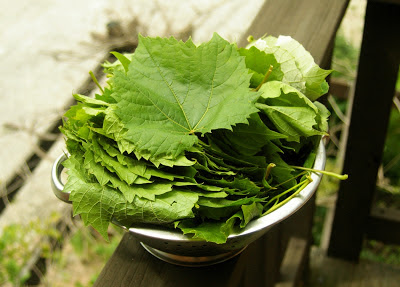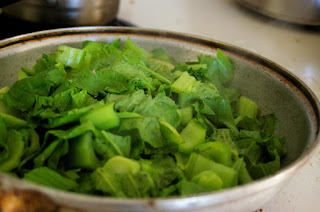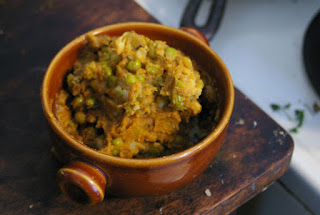Interesting connections aside, hibiscus tea makes a fabulous summer drink, crisply tart and refreshing with a striking ruby hue. Known in Spanish as agua de jamaica, it is one of several classic aguas frescas with roots in Mexico. Lightly sweet coolers that go a ways toward quenching both thirst and heat, other common aguas frescas include sweet, tangy tamarindo (tamarind), creamy horchata (a sweet rice milk with cinnamon), and smooth sandía (watermelon).
So with all this talk of Jamaica, Ethiopia and Mexico, on to July 4th. This July 4th was a blast. We took a little road trip to Cambridge for my friend Meaghan's South Pacific tiki-themed party, complete with pig on a spit (here's Neko in position under the serving table, watching the ground hopefully). Although, interestingly, it was hotter in Cambridge than in Honolulu that day, by about 10°. Meaghan, whom I play music with, is one of two the proprietresses of Booze Époque, a Cambridge-based mobile cocktail magic outfit (always a good friend to have). Meaghan and her BÉ collaborator, Harmony, created a number of delicious concoctions for the party (with and without booze), they also held a tiki drink contest. Contestants concocted their own summery drink with the requirement that it include at least one local ingredient. Among a number of interesting and tasty entries, I am honored to say my Jamaica Jerk Cooler ended up taking the grand prize Cthulhu-on-vacation tiki sculpture.
As I've said before, my family's recipe secret is that we don't keep secrets about recipes, so here's how you make it. The drink takes advantage of good lessons learned from aguas frescas, combining hibiscus and watermelon juice with a syrup made with honey and steeped with spices you might find in a jerk marinade - allspice, cinnamon and chipotle pepper (in most jerk spice mixes, this would be Scotch Bonnet peppers, but I wanted the smokiness of the chipotle here). It is also good with a little gin in it, but it's delicious without as well.
Jamaica Jerk Cooler
- Makes about 3 quarts
- 1 ½ c. dried hibiscus flowers
- 2 qts water
- 1 qt watermelon juice (I'll go into more detail below about how much watermelon you need for this much juice)
- 2 c. honey jerk syrup, below
- lime wedges
- gin (1 oz. per serving or about 1½ c. for whole recipe)
- 3-4 whole chipotle peppers, not in sauce
- 2 Tblsp. whole allspice
- 4 cinnamon sticks
- 1 c. water
- 1 c. honey
Honey Jerk Syrup
Next, make the hibiscus tea. Put 1 quart of water and the dried hibiscus into a saucepan. Bring to a boil, then turn off heat and let steep for about an hour. Strain and add the remaining quart of water.
As far as the watermelon juice, I started with a melon weighing about 10 lbs and ended up with about 10 cups of juice: what you see at right, plus another quart. I'm enjoying having the extra watermelon juice around (see below), but you probably only need about 6 cups of cut up watermelon to get a quart of juice. To juice the watermelon, cut it off the rind and put it in a blender or food processor. Blend for a few minutes, until there are no visible chunks. Pour through a fine mesh sieve and press through with a spatula or spoon. True to its name, watermelon is primarily water, and what you see in the mason jar at right is all the pulp left from the entire 10 pound watermelon. There's about a cup of it, relative to the 10 cups of juice, and it's great to eat chilled, with a spoon when it's really hot out.
If you plan to make this punch alcoholic, add about 1½ cups of gin to the total (or to taste). You can also mix it by the serving, adding about 1 oz. of gin to 8 oz. of punch. With or without alcohol, serve each cup with one or more lime wedges.
On using up the Watermelon
Making watermelon juice is a great way of reclaiming the fridge space taken by a languishing piece of melon. I've been having fun playing with watermelon juice this summer. It's a great base for all kinds of drinks. One of my favorite cool down drinks right now is a cup of watermelon juice, half a lime and a can (12 oz.) of seltzer. It pairs really well with citrus, mint, and many other fruits.Additionally, for extra points in not wasting ingredients, here's my recipe for watermelon rind pickles.


















